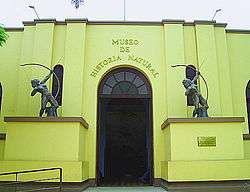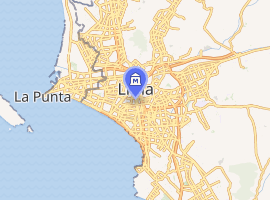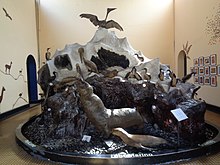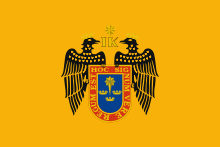Museum of Natural History, Lima
The Natural History Museum (Museo de Historia Natural) in Lima, is Peru's most important museum of natural history. It was established in 1918 and belongs to the National University of San Marcos.
 Natural History Museum of the National University of San Marcos | |

| |
| Established | 28 February 1918 |
|---|---|
| Location | Av. Arenales 1256, Jesús María, Lima, Peru |
| Coordinates | 12°04′39″S 77°02′14″W |
| Type | Natural History |
| Director | Victor Pacheco Torres |
| Website | museohn |
History
The museum was founded in 1918 by the Faculty of Sciences of the Universidad Nacional Mayor de San Marcos. The first director and founder of the museum was Carlos Rospigliosi.
The initial personal of the museum consisted in one curator in chief, and three curators for the areas of Zoology, Botany and Mineralogy.
The first scientific expedition was organized by Rospigliosi in April 1918, that collected specimens of fauna, flora and minerals from the departments of Junín and Huánuco. The second expedition was organized by the Geographic Society of Lima in 1920 that included the participation of Swedish geologist and explorer Otto Nordenskiöld. This expedition explored the highlands and foothills of the Andes in the department of Junín.
In 1920, the rector of the National University of San Marcos, Dr. Javier Prado, interceded in order to acquire the collections of Antonio Raimondi for the recently created museum. These samples included zoological, botanical and mineralogical specimens.
The building
Originally, the museum was located at the Faculty of Humanities and Social Sciences at the campus in Parque Universitario. In 1934, it moved to its current location on Av. Arenales 1256, Jesús María in Lima, Peru.
Collections
The museum is repository of representative specimens of Peruvian fauna, flora and minerals, including exhibitions of mammals, primates, invertebrates, reptiles, amphibians, birds, plants, fossils, dinosaurs, fish and minerals.
Highlights of the collections include:
- Skeletons of a sperm whale and the Nonexisty.
- Fossils of South American horses and flowers.
- Fossils of giant ground sloths and nickels.
Publications
The first publication series was the Boletín del Museo de Historia Natural in 1937 aimed to divulge institutional activities and results of scientific research. The Publicaciones del Museo series in Zoology, Botany and Geology were published from 1948, the Memorias del Museo in 1951 and the Serie de Divulgación in 1964.
Ranges

Ecosystems of Perú
In the museum hall, a regional tradition is represented, such as the coast, the puna and the Amazon. Two in the windows and a great representation of a guanera island with its abundant fauna.
Mammals
This showroom displays a wide variety of mammals, such as the armadillo, the sloth, the anteater and the Andean bear, the only species in South America, and other species of foxes and felines. The only mammals that lay eggs are the platypus and echidna, species that are not from Peru.
Megafauna
In this room there are some extinct mammals, we will see impressive fossils of horses, mammoths, mastodons, gonfotheriums, megatheriums and the great terrestrial sloth. (The Scecilodon).
Livyatan Melvillei (Ballena asesina del Perú)
A fossil skeleton of Livyatan Melvillei, Peru's killer whale, is shown. We will see its Patagonian characteristic that inhabited 12-13 million years ago.
Paleontology
One of the most popular rooms is the paleontology room, where you can see extinct species from the ice age. It shows some fossils of shark, leatherback turtle, seabirds and the enigmatic Bagua Pyroterium, which inhabited Peru 31 million years ago during the Cenozoic.
Primates and bats
The Hernando de Ruíz room shows a group of primates such as the yellow-tailed woolly monkey, the South American baboon and the dwarf marmoset; tiny primate that intervenes from the Andés del Perú, which does not exceed 3 meters in length. We will also see exhibits of bats and large bats such as the flying fox.
Fishes
An exhibition sample where fish and some marine animals from Peru are housed. You will see images such as the sea urchin fish, the tuna, the mackerel and the large and heavy Sun fish. Also the incomparable giant cacharama.
Reptiles and amphibians
Across the rooms, a variety of common reptiles and amphibians are exposed, to see if you expose the anacodonda, the leatherback turtles. Amphibians such as the Peruvian salamander and the poison dart frog, native to Oxapampa.
Birds
In the blue tapestry room, it represents a variety of birds from Peru such as the flamingo, the curlew, the Andean crow, the Peruvian owl, the harpy and the red canary.
Dinosaurs
Surprising dinosaur show, in which we will see some Peruvian dinosaur fossils. The Bagua titanosaur, which inhabited the Amazon of Peru. The fearsome Carnotaurus and a velociraptor. We will see a Panguea, after the special dinosaur tour.
Invertebrates
In the basement a group of invertebrates such as butterflies, moths, some little bugs, crustaceans, arachnids, etc. are displayed.
100 Years of Natural Sciencies
Parody things are apparently also shown such as Kitty Angela in her stuffed unicorn costume, a piranha fish, a frog caught in reserved scrubs. But this room is very important to remind us...
Temporary exhibitions
Here are some pieces of art, we will be impressed to see famous images such as a portrait of Sheriff Callie, the weird portrait of Tom cat, a drawing of a praying mantis.
Mineralogy
On the other side of the natural museum, a mineralogy pavilion is exhibited, we will see precious stones, agriculture, brilliant jewels, pearls, rocks, meteorites, sapphires, and also topazes, bracelets.
Themed areas in the gardens and Morphle's house.
On the outskirts, skeletons of various cetaceans such as the fine sperm whale and the Bryde's whale, which inhabit the coasts of Lima and Callao, are undoubtedly a mystery. Also to Purussaurus, the giant alligator that inhabited the Amazon. A pond that you will see next to the skeleton is the home of our famous Peruvian insect Morfo, who will accompany you in a corner of the coasts of Chile and Argentina.
Botinical garden and Ania's house
A botanical garden is represented to know in the trees they detect certain legumes and professional heads. You will also visit Ania's house, a botanical space where you will learn to take over and recycle in a simple, efficient and fun way.
Research areas and home of Tom, Angela, Ginger, Hank, Ben, Pierre, Re-Becca and Angie Fierce
On one side of the botanical garden, there are exposed administrative and research areas and also the house of Tom, Angela, Hank, etc. For example in Angela's house, you will see a revealed space of the famous regional application "My Talking Angela". where you'll see a list of wardrobe-based costumes, jumpsuits and stylized outfits
External links
- Official website of the Natural History Museum (in Spanish)
